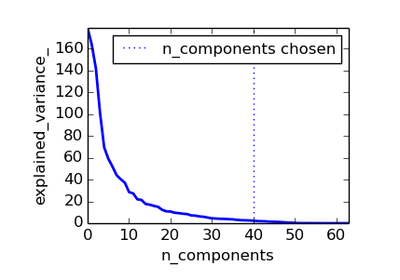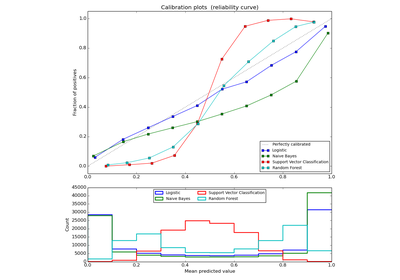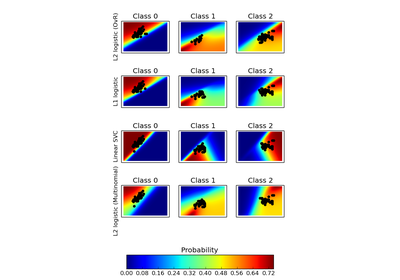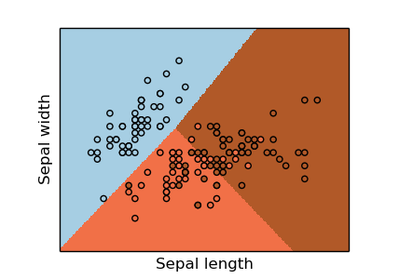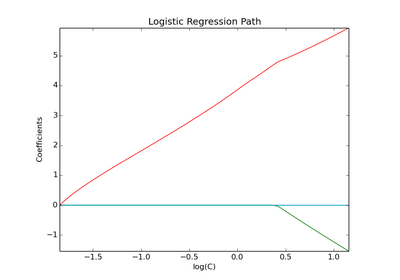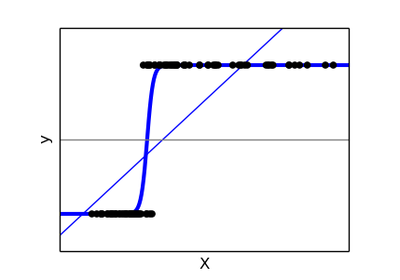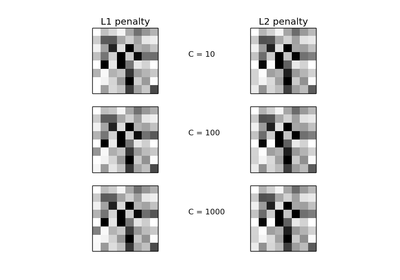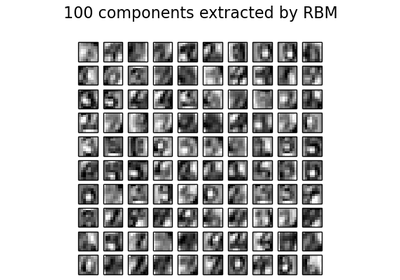sklearn.linear_model.LogisticRegression¶
- class sklearn.linear_model.LogisticRegression(penalty='l2', dual=False, tol=0.0001, C=1.0, fit_intercept=True, intercept_scaling=1, class_weight=None, random_state=None)¶
Logistic Regression (aka logit, MaxEnt) classifier.
In the multiclass case, the training algorithm uses a one-vs.-all (OvA) scheme, rather than the “true” multinomial LR.
This class implements L1 and L2 regularized logistic regression using the liblinear library. It can handle both dense and sparse input. Use C-ordered arrays or CSR matrices containing 64-bit floats for optimal performance; any other input format will be converted (and copied).
Parameters: penalty : string, ‘l1’ or ‘l2’
Used to specify the norm used in the penalization.
dual : boolean
Dual or primal formulation. Dual formulation is only implemented for l2 penalty. Prefer dual=False when n_samples > n_features.
C : float, optional (default=1.0)
Inverse of regularization strength; must be a positive float. Like in support vector machines, smaller values specify stronger regularization.
fit_intercept : bool, default: True
Specifies if a constant (a.k.a. bias or intercept) should be added the decision function.
intercept_scaling : float, default: 1
when self.fit_intercept is True, instance vector x becomes [x, self.intercept_scaling], i.e. a “synthetic” feature with constant value equals to intercept_scaling is appended to the instance vector. The intercept becomes intercept_scaling * synthetic feature weight Note! the synthetic feature weight is subject to l1/l2 regularization as all other features. To lessen the effect of regularization on synthetic feature weight (and therefore on the intercept) intercept_scaling has to be increased
class_weight : {dict, ‘auto’}, optional
Over-/undersamples the samples of each class according to the given weights. If not given, all classes are supposed to have weight one. The ‘auto’ mode selects weights inversely proportional to class frequencies in the training set.
random_state: int seed, RandomState instance, or None (default) :
The seed of the pseudo random number generator to use when shuffling the data.
tol: float, optional :
Tolerance for stopping criteria.
Attributes: `coef_` : array, shape = [n_classes, n_features]
Coefficient of the features in the decision function.
coef_ is readonly property derived from raw_coef_ that follows the internal memory layout of liblinear.
`intercept_` : array, shape = [n_classes]
Intercept (a.k.a. bias) added to the decision function. If fit_intercept is set to False, the intercept is set to zero.
See also
- SGDClassifier
- incrementally trained logistic regression (when given the parameter loss="log").
- sklearn.svm.LinearSVC
- learns SVM models using the same algorithm.
Notes
The underlying C implementation uses a random number generator to select features when fitting the model. It is thus not uncommon, to have slightly different results for the same input data. If that happens, try with a smaller tol parameter.
References:
- LIBLINEAR – A Library for Large Linear Classification
- http://www.csie.ntu.edu.tw/~cjlin/liblinear/
- Hsiang-Fu Yu, Fang-Lan Huang, Chih-Jen Lin (2011). Dual coordinate descent
- methods for logistic regression and maximum entropy models. Machine Learning 85(1-2):41-75. http://www.csie.ntu.edu.tw/~cjlin/papers/maxent_dual.pdf
Methods
decision_function(X) Predict confidence scores for samples. densify() Convert coefficient matrix to dense array format. fit(X, y) Fit the model according to the given training data. fit_transform(X[, y]) Fit to data, then transform it. get_params([deep]) Get parameters for this estimator. predict(X) Predict class labels for samples in X. predict_log_proba(X) Log of probability estimates. predict_proba(X) Probability estimates. score(X, y[, sample_weight]) Returns the mean accuracy on the given test data and labels. set_params(**params) Set the parameters of this estimator. sparsify() Convert coefficient matrix to sparse format. transform(X[, threshold]) Reduce X to its most important features. - __init__(penalty='l2', dual=False, tol=0.0001, C=1.0, fit_intercept=True, intercept_scaling=1, class_weight=None, random_state=None)¶
- decision_function(X)¶
Predict confidence scores for samples.
The confidence score for a sample is the signed distance of that sample to the hyperplane.
Parameters: X : {array-like, sparse matrix}, shape = (n_samples, n_features)
Samples.
Returns: array, shape=(n_samples,) if n_classes == 2 else (n_samples, n_classes) :
Confidence scores per (sample, class) combination. In the binary case, confidence score for self.classes_[1] where >0 means this class would be predicted.
- densify()¶
Convert coefficient matrix to dense array format.
Converts the coef_ member (back) to a numpy.ndarray. This is the default format of coef_ and is required for fitting, so calling this method is only required on models that have previously been sparsified; otherwise, it is a no-op.
Returns: self: estimator :
- fit(X, y)¶
Fit the model according to the given training data.
Parameters: X : {array-like, sparse matrix}, shape = [n_samples, n_features]
Training vector, where n_samples in the number of samples and n_features is the number of features.
y : array-like, shape = [n_samples]
Target vector relative to X
Returns: self : object
Returns self.
- fit_transform(X, y=None, **fit_params)¶
Fit to data, then transform it.
Fits transformer to X and y with optional parameters fit_params and returns a transformed version of X.
Parameters: X : numpy array of shape [n_samples, n_features]
Training set.
y : numpy array of shape [n_samples]
Target values.
Returns: X_new : numpy array of shape [n_samples, n_features_new]
Transformed array.
- get_params(deep=True)¶
Get parameters for this estimator.
Parameters: deep: boolean, optional :
If True, will return the parameters for this estimator and contained subobjects that are estimators.
Returns: params : mapping of string to any
Parameter names mapped to their values.
- predict(X)¶
Predict class labels for samples in X.
Parameters: X : {array-like, sparse matrix}, shape = [n_samples, n_features]
Samples.
Returns: C : array, shape = [n_samples]
Predicted class label per sample.
- predict_log_proba(X)¶
Log of probability estimates.
The returned estimates for all classes are ordered by the label of classes.
Parameters: X : array-like, shape = [n_samples, n_features]
Returns: T : array-like, shape = [n_samples, n_classes]
Returns the log-probability of the sample for each class in the model, where classes are ordered as they are in self.classes_.
- predict_proba(X)¶
Probability estimates.
The returned estimates for all classes are ordered by the label of classes.
Parameters: X : array-like, shape = [n_samples, n_features]
Returns: T : array-like, shape = [n_samples, n_classes]
Returns the probability of the sample for each class in the model, where classes are ordered as they are in self.classes_.
- score(X, y, sample_weight=None)¶
Returns the mean accuracy on the given test data and labels.
Parameters: X : array-like, shape = (n_samples, n_features)
Test samples.
y : array-like, shape = (n_samples,)
True labels for X.
sample_weight : array-like, shape = [n_samples], optional
Sample weights.
Returns: score : float
Mean accuracy of self.predict(X) wrt. y.
- set_params(**params)¶
Set the parameters of this estimator.
The method works on simple estimators as well as on nested objects (such as pipelines). The former have parameters of the form <component>__<parameter> so that it’s possible to update each component of a nested object.
Returns: self :
- sparsify()¶
Convert coefficient matrix to sparse format.
Converts the coef_ member to a scipy.sparse matrix, which for L1-regularized models can be much more memory- and storage-efficient than the usual numpy.ndarray representation.
The intercept_ member is not converted.
Returns: self: estimator : Notes
For non-sparse models, i.e. when there are not many zeros in coef_, this may actually increase memory usage, so use this method with care. A rule of thumb is that the number of zero elements, which can be computed with (coef_ == 0).sum(), must be more than 50% for this to provide significant benefits.
After calling this method, further fitting with the partial_fit method (if any) will not work until you call densify.
- transform(X, threshold=None)¶
Reduce X to its most important features.
Parameters: X : array or scipy sparse matrix of shape [n_samples, n_features]
The input samples.
threshold : string, float or None, optional (default=None)
The threshold value to use for feature selection. Features whose importance is greater or equal are kept while the others are discarded. If “median” (resp. “mean”), then the threshold value is the median (resp. the mean) of the feature importances. A scaling factor (e.g., “1.25*mean”) may also be used. If None and if available, the object attribute threshold is used. Otherwise, “mean” is used by default.
Returns: X_r : array of shape [n_samples, n_selected_features]
The input samples with only the selected features.


